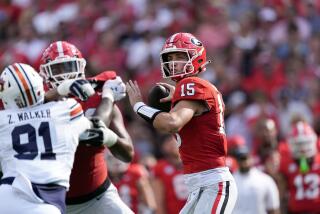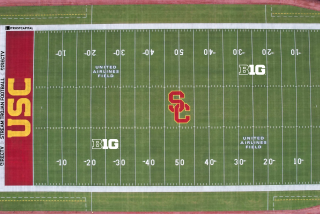COLLEGE FOOTBALL BOWL GAMES : HOKIE-DOKEY : Virginia Tech Is the Big Winner in $100-Million Bowl Bonanza With a $3.5-Million Payday
NEW ORLEANS — The largest contributor to Virginia Tech’s athletic program this year is Paul Dee, athletic director at the University of Miami.
When Dee decided to ask the NCAA to take the Hurricanes out of the bowl picture to begin its punishment for various football transgressions, Virginia Tech became the beneficiary of $3.5 million. That’s the amount determined by the Big East Conference as the reward to its one bowl alliance representative.
Dave Braine didn’t send a thank-you note.
“We beat Miami and we’re ranked higher than Miami,” Braine, Virginia Tech’s athletic director, said. “And the Sugar Bowl has been looking at us for a long time.”
The Orange Bowl was looking at higher-profile Miami--the Big East’s co-champion with Virginia Tech in the absence of a tiebreaker--ready to award the Hurricanes what would be virtually a home game against Notre Dame.
The $3.5 million is part of bowl payouts that total $100,790,000 for 18 games this season, and Virginia Tech--not No. 1 Nebraska or No. 2 Florida, playing in the Fiesta Bowl for a national title--is the big winner, if you discount independent Notre Dame and its unshared $8.33-million Orange Bowl take.
The Big East, in its first year of revenue sharing, gives its bowl-alliance representative--Virginia Tech--$3.5 million for playing in an alliance bowl. By comparison, Big Eight representative Nebraska gets $1.5 million for playing in the Fiesta.
Miami, which almost certainly would have been the Big East alliance representative had it not pulled out of the bowl picture, gets $578,750 as a Big East member. Virginia Tech gets that too, on top of the $3.5 million.
All schools in a conference get a share of the bowl payout of fellow schools playing in bowl games, but every conference deals with bowl money differently.
“We’re more communistic,” said Pacific 10 spokesman Jim Muldoon. “Everybody gets the same, after expenses.”
Unlike at most universities in this day of conference bowl tie-ups and predictable bowl revenue, it’s found money for Virginia Tech.
“They wouldn’t allow us to budget any bowl money because it’s the first year of revenue sharing in the Big East,” Braine said.
“We’re building a $6.7-million addition to the athletic complex and we’ve raised about $5 million, so some money will go for that,” Braine said, reeling off his shopping list. “We’ve raised all but $67,000 for a $500,000 baseball stadium, and now that’s covered.”
At most schools, the money is spent months before it’s earned.
“We budget revenue based on bowls we have contracts with,” said Dutch Baughman, athletic director at Oregon State, which hasn’t been in a bowl since 1965, but which gets $896,550 as its share of the Rose, Cotton, Sun, Aloha and Liberty bowls played in by Pac-10 teams. “When we have additional teams [as with Stanford in the Liberty, though its $750,000 expense account is equal to the game’s guarantee], the money goes in the general revenue fund.”
The same is true at Wisconsin, which gets a Big Ten share of $770,833--largely from the Rose Bowl, though there are six conference teams in bowls this year--and does not have a bowl game. About 3% of the school’s $30-million budget is funded by bowl revenue, more if you count the residual effect of the Badgers’ appearance in the 1994 Rose Bowl.
“We have contracts with five bowls and that allows you to budget revenue from those bowls,” said Pat Richter, Wisconsin’s athletic director. “And since we went to the Rose Bowl, we have more revenue from the sales of licensed products. Before we went to the Rose Bowl, we sold about $325,000 in licensed products. Now it’s $1.4 million.”
And if it wasn’t there? “Well, the impact would probably be felt on spring sports,” Richter said. “You have to have a high-profile football program to have a successful athletic program.”
Jeremy Foley, Florida’s athletic director, is more succinct.
“You don’t kill the goose that laid the golden egg,” he said. “We have a new volleyball facility and a new volleyball coach, Mary Wise. And she loves [football Coach] Steve Spurrier.”
Every conference has its own way of dealing with bowl revenue, and most member schools assume the worst: sitting home after Christmas. That helped Miami cope with losing $3.5 million it never really had.
“We weren’t allowed to budget bowl revenue, even though we’re usually in a bowl,” said Larry Wahl, associate athletic director at Miami. “There’s an impact, of course, because everybody would love to have $3.5 million for its program, but it wasn’t planned, so we can deal with it.”
And every athletic director reminds you that bowl teams have expenses.
“Everybody thinks we’re getting $8.58 million for playing in the Fiesta Bowl,” Florida’s Foley said. “Actually, we’re getting about $2.1 million, and we pay expenses out of that. We’d get about a half-million [SEC team Fiesta Bowl share] if we weren’t playing in it.”
The expense factor is a big one. The Rose Bowl payout is $8.1 million per team, and the Pac-10 sets a $902,000 expense account for its Rose Bowl representative before dividing the rest of the money among league members.
That means USC gets $902,000 for going across town to play Northwestern, plus the same bowl share as Oregon State.
The $902,000 is about right, say Trojan officials.
With school out, USC houses and feeds about 150 players, coaches, trainers, equipment personnel and others for two weeks; buys Rose Bowl watches and rings for them; houses and feeds the Trojan band for a week; ferries everybody about for various bowl functions and practices; deals with the cost of selling about 41,000 Rose Bowl tickets and buys a few for VIPs and four each for players to give to families or whomever; then throws appropriate parties for alumni and financial supporters of the athletic program as a season-ending reward.
Northwestern gets $1.2 million for all that, plus pays for transportation to Southern California.
Florida gets $2,173,600 for playing in the Fiesta, about $1 million more than it will spend. Mississippi State, which does not play in a bowl, gets $533,866.67 for watching the game on TV.
Florida’s opponent, Nebraska, gets $1.5 million. Most of its $1,103,750 Big Eight share was already budgeted. The league goes so far as to line up charter flights during the summer for teams it knows will be playing in an alliance bowl--the Sugar, Orange and Fiesta--and Aloha, Holiday and Cotton bowls. Because it knows its representative will lose money with the Aloha Bowl payout--$800,000, including the cost of 7,500 tickets, most of which this year’s team, Kansas, could not sell--it awards an extra $200,000 to its representative in the game.
UCLA, Kansas’ opponent, had no such conference support, getting $750,000 in expenses, plus the cost of 150 round-trip plane tickets to Hawaii. That’s why the Bruins struggled to break even, sending only the 40 members of their band required by contract to cut costs.
Still, UCLA picks up an $896,550 conference share, largely for USC’s playing in the Rose Bowl and Oregon’s playing in the Cotton.
And Virginia Tech?
“We’ve raised $1 million for a $1.8-million track-soccer complex, and now that’s finished,” said Braine, still shopping.
“And we’ll donate to academics.”
A year ago, with unbudgeted Gator Bowl revenue, Virginia Tech endowed a professorship. After all the high finance here, we’re still talking about college.
(BEGIN TEXT OF INFOBOX / INFOGRAPHIC)
The Money Trail
$100,790,000. That’s how much money is at play during postseason college football games. So where does it all go? Here’s an estimate of how the wealth is shared. All figures are best estimates based on minimum established bowl payout. Some bowls often exceed minimums.
PAYDAYS Posted bowl minimum payouts per team. Teams and conferences vary on distribution of funds: Fiesta: $8.58 million
Orange: $8.33 million
Sugar: $8.33 million
Rose: $8.1 million
Citrus: $3 million
Cotton: $2.5 million
Outback: $1.5 million
Holiday: $1.5 million
Gator: $1.3 million
Peach: $1.13 million
Carquest: $1 million
Alamo: $1 million
Sun: $900,000
Aloha: $800,000
Liberty: $750,000
Independence: $750,000
Copper: $750,000
Las Vegas: $175,000
PACIFIC 10 (5 bowls, $13.1 million)
*--*
School Bowl Expenses Share Total USC Rose Bowl $902,000 $896,550 $1,798,550 UCLA Aloha $750,000* $896,550 $1,646,550 Oregon Cotton $750,000** $896,550 $1,646,550 Washington Sun $750,000* $896,550 $1,646,550 Stanford Liberty $750,000* $896,550 $1,646,550 All others $896,550 $896,550
*--*
*Plus 150 round-trip air fares, est. $400 each
**Plus 325 round-trip air fares, est. $400 each
(Note: Bowl money after expenses is divided 10 ways)
BIG TEN (6 bowls, $15.35 million)
*--*
School Bowl Expenses Share Northwestern Rose $1.1 million $770,833 Other bowl teams (Michigan, Iowa, Penn State, Ohio State, Michigan State) $1 million $770,833 All other schools $770,833
School Total Northwestern $1,870,833 Other bowl teams (Michigan, Iowa, Penn State, Ohio State, Michigan State) $1,770,833 All other schools $ 770,833
*--*
(Note: Bowl money after expenses is divided 12 ways, the conference taking one share)
ATLANTIC COAST CONFERENCE (4 bowls, $11.78 million)
*--*
School Bowl Expenses Share Total Florida State Orange $1.25 million $895,000 $2,145,000 North Carolina Carquest $750,000 $895,000 $1,645,000 Virginia Peach $825,000 895,000 $1,720,000 Clemson Gator $900,000 895,000 $1,795,000 All others 895,000 $895,000
*--*
BIG EAST (2 bowls, $9.63 million)
*--*
School Bowl Expenses Share Total Virginia Tech Sugar $3.5 million $578,750 $4,078,750 Syracuse Gator $1.5 million $578,750 $2,078,750 All others $578,750 $578,750
*--*
BIG EIGHT (4 bowls, $13.33 million)
*--*
School Bowl Expenses Share Total Nebraska Fiesta $1.5 million $1,103,750 $2,603,750 Other Bowl Teams $1 million $1,103,750 $2,103,750 (Kansas, Kansas St., Colorado) All others $1,103,750 $1,103,750
*--*
SOUTHWEST (3 bowls, $10,080,000)
*--*
School Bowl Expenses Share Total Texas Sugar $1.6 million $866,250 $2,466,250 Texas Tech Copper $750,000 $866,250 1,616,250 Texas A&M; Alamo $800,000 $866,250 1,666,250 All others $866,250 $866,250
*--*
SOUTHEASTERN (6 bowls, $15.96 million)
*--*
School Bowl Expenses Share Florida Fiesta $2,173,600 $268,666.50 LSU Independence $630,000 $792,533.10 Arkansas Carquest $680,000 $775,866.50 Georgia Peach $826,000 $777,199.80 Auburn Outback $780,000 $742,533.10 Tennessee Citrus $1,240,000 $655,866.50 All others and conference office $802,533 $802,533
School Total Florida $2,442,266 LSU $1,422,533 Arkansas $1,455,866 Georgia $1,603,199 Auburn $1,522,533 Tennessee $1,895,866 All others and conference office
*--*
Note: Figures will not add to exactly $15.96 million because the SEC also takes expenses to buy “bowl minimum insurance.”
WESTERN ATHLETIC (2 bowls, $2.25 million)
*--*
School Bowl Expenses Share Total Colorado State Holiday $800,000 $58,333.33 $858,333.33 Air Force Copper $750,000 $58,333.33 $808,333.33 All others $58,333.33 $58,333.33
*--*
OTHERS
*--*
School Bowl Total Notre Dame Orange $8,330,000 East Carolina Liberty $750,000
*--*
More to Read
Go beyond the scoreboard
Get the latest on L.A.'s teams in the daily Sports Report newsletter.
You may occasionally receive promotional content from the Los Angeles Times.










